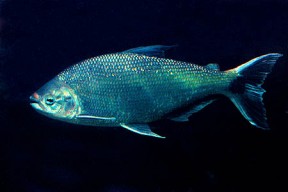Brycon cephalus
Red-tailed Brycon
Classification
Characidae. Subfamily: Bryconinae
Distribution
Native to the Upper Amazon basin in Peru, Bolivia and Brazil.
Habitat
Tends to inhabit the flowing central parts of both white and black water rivers. It can be seen resting in loose shoals around the banks, under cover of vegetation. It can also be found in areas of flooded forest, and lakes and pools (known locally as “várzeas“) left behind when the flood waters recede.
Maximum Standard Length
The officially recorded maximum size is 8.8″ (22cm) although apparently it can grow much larger than this. Some reports suggest it can reach as much as 18″ (45cm).
Aquarium SizeTop ↑
A very active species that needs a tank measuring at least 84″ x 24″ x 24″ (180cm x 60cm x 60cm) – 793 litres.
Maintenance
As it’s a pelagic, riverine species a good flow of well oxygenated water through the tank is required. The choice of decor isn’t critical, but a substrate of sand with a few driftwood branches, and perhaps some smooth, water-worn rocks would look very effective. Try to leave as much open swimming space as possible. Make sure the tank is well covered, as it’s an excellent jumper.
Water Conditions
Temperature: 72-79°F (22-26°C)
pH: 5.5-7.5
Hardness: 1-15°H
Diet
In nature it’s something of an opportunist, consuming a range of small fish and aquatic invertebrates, as well as fruits, nuts and seeds. It proves similarly unfussy in the aquarium, although it does show a preference for meaty foods. Offer a mixture of live, frozen and dried foods. Prawns and live earthworms are particularly relished.
Behaviour and CompatibilityTop ↑
Tankmates should be chosen carefully, given its dynamic, predatory nature. Don’t keep it with anything very delicate or slow moving. Possible tankmates include Cichla sp. and other robust cichlids, larger characins, cyprinids and catfish. It’s a shoaling fish by nature and ideally should be kept in a group. A certain level of intraspecific aggression is inevitable though, as a pecking order is established. Aim to buy at least 5 or 6, as when maintained in smaller numbers it’s not uncommon for a particular individual to be singled out for bullying or worse.
Sexual Dimorphism
No definitive information is available. Sexually mature females are likely to be thicker-bodied than males, though.
Reproduction
Not thought to have been achieved in the hobby. The species has a complicated migratory spawning cycle in nature (see below).
NotesTop ↑
The Brycon genus is large, at present containing over 50 species. A number of these are very similar, a couple of which (B. rubricauda and B. orbignyanus) resemble B. cephalus quite closely. However this one is the most common in nature and is likely to be the species seen on sale most often.
Commonly known as the matrinxã in Brazil, it has an interesting life cycle, migrating twice per year over large distances according to the season. The first movement occurs at the start of the wet season, when it moves from nutrient-poor clear and black water tributaries into more turbulent white (silt-laden) rivers to spawn. Some populations may travel several hundred kilometres to reach their destination. Post spawning the eggs drift downstream and onto the nutrient-rich floodplains where the fry can find plentiful food. Post spawning the adults return to precisely the tributaries from where they came to feed for the following few months.
It migrates again in the middle of the flooding season, moving once more from the nutrient-poor tributaries into the nutrient-rich upstream rivers. Here it remains until the water level begins to drop. At this point a final move back once more into the nutrient-poor tributaries occurs.
It’s not seen all that often in the trade but makes an impressive shoaling fish for the community of larger fish. If you look closely you’ll notice it has a mouth full of tiny, sharp teeth. Combined with its streamlined body shape, this makes for an efficient predator. It’s also a popular sport fish in some of its native habitats, and is reputed to fight hard for its size.




